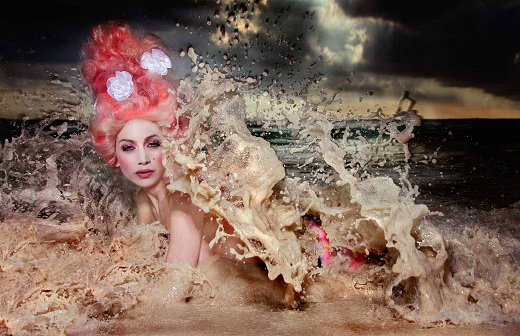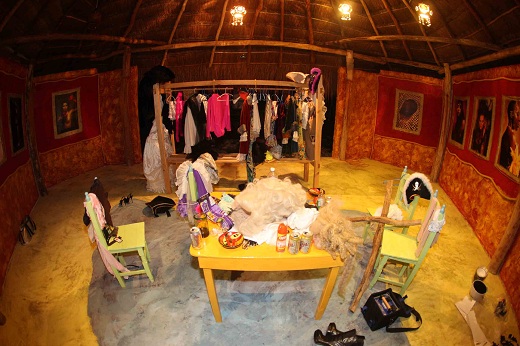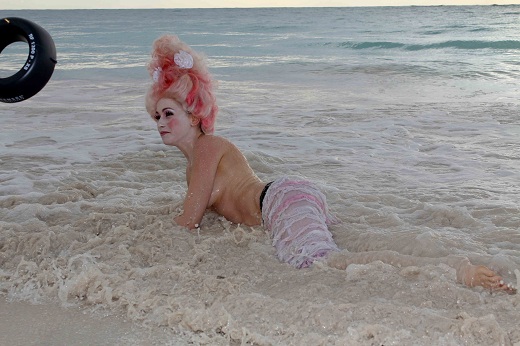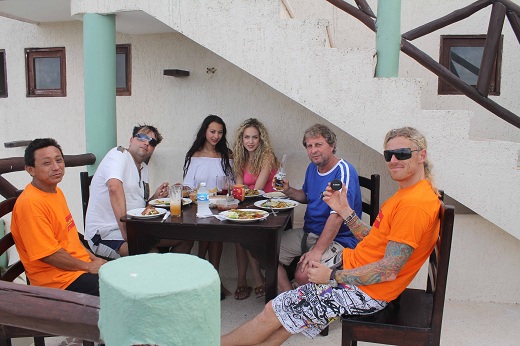Anatomy of an image: La diosa de las olas
This article is written by a member of our expert
community. It expresses that member’s views only. We welcome other
perspectives. Here’s how to contribute to EDU.
On May 26th, 2011 I had an opening of my new exhibition called Teatro Caribe. I presented 21 large format photographs, shot especially for this exhibition on the beautiful beaches of The Riviera Maya and other exotic locations in the area.
From the very beginning of the project I was certain about the style of the photos. My concept was to shoot provocative glamour photos in a decadent way, using original baroque styling. It gave all the photos the intended theatrical effect. The concept was clear, but the initial idea was challenging. There were several important things we had to put together, like hiring a very good make-up artist specializing in such theatrical looks, and a stylist who could rent part of the costumes and make the rest to fit the measurements of the models. In the end the most important thing was finding the right models. After three castings, we finally hired five models. One of them was my favorite glamor and fashion model, Libuska Rehakova. Now I’m getting to the point of my contribution…
Let me introduce one of the most successful photos of this project, which was called, “La diosa de las olas” (which means “The Goddess of the Waves”). I’m going to show Model members how such a photograph came to exist.

A lot of people asked me the same question—is the water real? Were the waves additionally photomontaged? No, they were not. Everything you see in the photo is real. Nothing is added. I think it is difficult to achieve such an effect within post-production work. The real wave mixed with sand gives a sort of “coffee” effect, which was something I had hoped for. To take such a strong picture there is a question of luck, but on the other hand having a good initial idea and know-how is how I achieved this stunning effect. Using the proper light, particularly a perfect combination of natural light with artificial is the first necessary step.
Lighting
This photo was taken March 3rd, 2011 at 7:24 am. The sun is just rising at that time in the Caribbean. It doesn’t give sunrise light, when the sun just emerges on the horizon, but a very dramatic warm contra light. Of course, this works only under the condition that a strong artificial light is used in front of the model.
For this photo I decided to use my Ring flash Hensel 1200 P-XS. This special strobe head, powered by Hensel porty 12 lithium power pack, gives a fantastic light effect. Usually it is used fitted properly on a camera lens. However this is not the case with this photo-session. When shooting outdoors, in the Caribbean, I work in a completely different way. My two Mayan assistants, which I use as a part of the production team when shooting in Mexico, were asked to fit the ring on one end of a two meter long stick. When staying in the area, I like to be as close to nature as possible, so I like the rustic look of such a fitted ring. With such a “patent light” I could instruct the assistants to set the light to the precise height and distance from the model I needed, and they could do it easily. In this case, the light was about 1.5m (5 feet) from Libuska, just above my head. That means I was at the same distance away from her. To take a picture like this, a photographer should stay very close to the model, using a wide angle lens (cca 50mm) to achieve a high depth of sharpness, to make the water as plastic as possible. Thanks to this, the viewer is dragged into the picture. The closer the flash is placed to the model, the harder light we get. Another important thing is the angle from which the light strikes a model. I always prefer that the light comes from above, more or less. The technique in this case “irons” the model’s face, makes visible plastic shadows under her nose and chin, and strong shadows in the water. The water makes such a great effect on this photo. (Thanks to using this type of lighting.) Of course this effect is also a question of the exposure, which in this case was 250/22f.

Okay, I mentioned the type of lighting, where the light was placed, exposure, but there’s still something very important missing, a very important technical parameter. It is an amazingly short flash duration. The ring flash 1200 P-XS flash duration is 1/1300 of a second. That is the “magic” of this picture—the water is frozen thanks to using this fantastic artificial light. The strobe can easily fight down the strong natural contra light, so much so that a photographer becomes a master of the situation and can use the balance of natural and artificial light at his/her pleasure.

Since this article is called “Anatomy,” I have to mention another important aspect of why this picture looks the way it does. First of all, the model must be special, sort of mystical and beautiful. Libuska Rehakova was obviously a perfect choice. Second, styling, hair, and make-up were pretty important. I made a very good decision again, when engaging Vilem Persy—artistic make-up artist and hair stylist. His work is fantastic. I didn’t have to explain to him for too long what I wanted to get from the situation. We’ve been working together for more than 10 years, so we know each other’s style very well. Last but not least, I’d like to mention the help of the whole production team, who worked to make this photograph come together.

Post-Production
The action of the photo is real, so my post-production editor only retouched the make-up a bit (splashing water destroyed it a little). We emphasized the colors, mainly the redness of her hair. The shadows were emphasized, especially in the water. The sky was really dark on the original photo. Despite this, we helped with slight fixing of the brightness and contrast to achieve an even more dramatic atmosphere. As to the post-production I want to mention one thing—today’s possibilities with Photoshop are fantastic, and they can really help, but only if the basic photo is a very good one. (At least concerning the category of art, classy glamor, and fashion or fine art nudity.) A photographer’s eye and conception is the most important part of the picture. The post-production, if the photo has the power, makes a very nice bonus.
 In the end, when I pulled the trigger of my camera, I had a very good
feeling I got what I wanted. Just a fraction of a second later I
realized the wave was too strong. Stronger than I expected. First it
struck around Libuska and her styling. Then I knew it was my turn.
Fortunately I was able to hold my hands up, so my camera survived.
Libuska’s hair, makeup, and styling didn’t. The photo-session was over
pretty fast. The first two attempts caught only small waves, the third
one was the good one—a bit unexpected and it was our last chance. We
were lucky, the picture was done.
In the end, when I pulled the trigger of my camera, I had a very good
feeling I got what I wanted. Just a fraction of a second later I
realized the wave was too strong. Stronger than I expected. First it
struck around Libuska and her styling. Then I knew it was my turn.
Fortunately I was able to hold my hands up, so my camera survived.
Libuska’s hair, makeup, and styling didn’t. The photo-session was over
pretty fast. The first two attempts caught only small waves, the third
one was the good one—a bit unexpected and it was our last chance. We
were lucky, the picture was done.
 A short summary of the photo-session:
A short summary of the photo-session:
Photographer: Roman Sluka
Model: Libuska Rehakova
Make-up, hair: Vilem Persy
Production: Yvonne Mueller
Assistants: Ekileo, Pivi¨
Postproduction: Vladena Fleissig, Thalia Picta
Camera: Canon EOS-1Ds Mark III
Lens: Canon 28 – 300 L
Lighting: Ring flash 1200 P-XS, power by Porty 12 Lithium
Exposure: 250/22f
Time, date: 07.24 am, March 3rd 2011
On May 26th, 2011 I had an opening of my new exhibition called Teatro Caribe. I presented 21 large format photographs, shot especially for this exhibition on the beautiful beaches of The Riviera Maya and other exotic locations in the area.
From the very beginning of the project I was certain about the style of the photos. My concept was to shoot provocative glamour photos in a decadent way, using original baroque styling. It gave all the photos the intended theatrical effect. The concept was clear, but the initial idea was challenging. There were several important things we had to put together, like hiring a very good make-up artist specializing in such theatrical looks, and a stylist who could rent part of the costumes and make the rest to fit the measurements of the models. In the end the most important thing was finding the right models. After three castings, we finally hired five models. One of them was my favorite glamor and fashion model, Libuska Rehakova. Now I’m getting to the point of my contribution…
Let me introduce one of the most successful photos of this project, which was called, “La diosa de las olas” (which means “The Goddess of the Waves”). I’m going to show Model members how such a photograph came to exist.

La diosa de las olas (The Goddess of the Waves)
A lot of people asked me the same question—is the water real? Were the waves additionally photomontaged? No, they were not. Everything you see in the photo is real. Nothing is added. I think it is difficult to achieve such an effect within post-production work. The real wave mixed with sand gives a sort of “coffee” effect, which was something I had hoped for. To take such a strong picture there is a question of luck, but on the other hand having a good initial idea and know-how is how I achieved this stunning effect. Using the proper light, particularly a perfect combination of natural light with artificial is the first necessary step.
Lighting
This photo was taken March 3rd, 2011 at 7:24 am. The sun is just rising at that time in the Caribbean. It doesn’t give sunrise light, when the sun just emerges on the horizon, but a very dramatic warm contra light. Of course, this works only under the condition that a strong artificial light is used in front of the model.
For this photo I decided to use my Ring flash Hensel 1200 P-XS. This special strobe head, powered by Hensel porty 12 lithium power pack, gives a fantastic light effect. Usually it is used fitted properly on a camera lens. However this is not the case with this photo-session. When shooting outdoors, in the Caribbean, I work in a completely different way. My two Mayan assistants, which I use as a part of the production team when shooting in Mexico, were asked to fit the ring on one end of a two meter long stick. When staying in the area, I like to be as close to nature as possible, so I like the rustic look of such a fitted ring. With such a “patent light” I could instruct the assistants to set the light to the precise height and distance from the model I needed, and they could do it easily. In this case, the light was about 1.5m (5 feet) from Libuska, just above my head. That means I was at the same distance away from her. To take a picture like this, a photographer should stay very close to the model, using a wide angle lens (cca 50mm) to achieve a high depth of sharpness, to make the water as plastic as possible. Thanks to this, the viewer is dragged into the picture. The closer the flash is placed to the model, the harder light we get. Another important thing is the angle from which the light strikes a model. I always prefer that the light comes from above, more or less. The technique in this case “irons” the model’s face, makes visible plastic shadows under her nose and chin, and strong shadows in the water. The water makes such a great effect on this photo. (Thanks to using this type of lighting.) Of course this effect is also a question of the exposure, which in this case was 250/22f.

Our studio during the styling preparation.
Okay, I mentioned the type of lighting, where the light was placed, exposure, but there’s still something very important missing, a very important technical parameter. It is an amazingly short flash duration. The ring flash 1200 P-XS flash duration is 1/1300 of a second. That is the “magic” of this picture—the water is frozen thanks to using this fantastic artificial light. The strobe can easily fight down the strong natural contra light, so much so that a photographer becomes a master of the situation and can use the balance of natural and artificial light at his/her pleasure.

A few seconds after taking the photo, Libuska´s makeup and hair was destroyed.
Since this article is called “Anatomy,” I have to mention another important aspect of why this picture looks the way it does. First of all, the model must be special, sort of mystical and beautiful. Libuska Rehakova was obviously a perfect choice. Second, styling, hair, and make-up were pretty important. I made a very good decision again, when engaging Vilem Persy—artistic make-up artist and hair stylist. His work is fantastic. I didn’t have to explain to him for too long what I wanted to get from the situation. We’ve been working together for more than 10 years, so we know each other’s style very well. Last but not least, I’d like to mention the help of the whole production team, who worked to make this photograph come together.

Checking the result.
Post-Production
The action of the photo is real, so my post-production editor only retouched the make-up a bit (splashing water destroyed it a little). We emphasized the colors, mainly the redness of her hair. The shadows were emphasized, especially in the water. The sky was really dark on the original photo. Despite this, we helped with slight fixing of the brightness and contrast to achieve an even more dramatic atmosphere. As to the post-production I want to mention one thing—today’s possibilities with Photoshop are fantastic, and they can really help, but only if the basic photo is a very good one. (At least concerning the category of art, classy glamor, and fashion or fine art nudity.) A photographer’s eye and conception is the most important part of the picture. The post-production, if the photo has the power, makes a very nice bonus.

Libuska at the scene of the photoshoot later that day.

An excellent Mexican lunch for the team after the successful photoshoot.
Photographer: Roman Sluka
Model: Libuska Rehakova
Make-up, hair: Vilem Persy
Production: Yvonne Mueller
Assistants: Ekileo, Pivi¨
Postproduction: Vladena Fleissig, Thalia Picta
Camera: Canon EOS-1Ds Mark III
Lens: Canon 28 – 300 L
Lighting: Ring flash 1200 P-XS, power by Porty 12 Lithium
Exposure: 250/22f
Time, date: 07.24 am, March 3rd 2011
No comments:
Post a Comment